Less than an hour ago,
Apple finished announcing what might have been the most hotly-anticipated
ultraportable device in the last ten years of information technology
innovation. For weeks,
months, and even years, rumors and analytic speculation of an Apple tablet
device have scourged the internet from every possible direction, and the
concrete evidence that the mass market consumer world has anticipated for so
long has only recently been confirmed from the corporation itself.
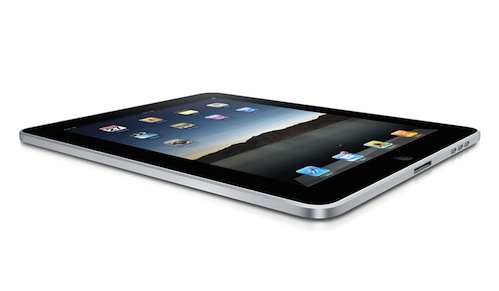
It is clearly no secret that
unannounced and upcoming Apple products tend to generate what some might
consider a ridiculously insane amount of hype, often in the name of flamboyant
fanaticism and absurd amounts of over-speculative imagination. Consider the fact that our friends at
Engadget recently constructed an entire rumor documentary on the glorified device,
explaining its history-in-the-making beginning way back in 1983.
Noticeable amounts of evidence
suggesting that an Apple tablet device actually existed and had been imagined
by internal corporate strategists and product engineers have been around since
early 2002. Within time, a design patent was filed by Apple in 2004 for a
“handheld computer” that listed Steve Jobs on the application as well as
Jonathan Ive, Senior Vice President of Industrial Design. Fast forward to
January 2010, and we have experienced what seems like the largest flood of
journalistic gadget fanboyism in the course of the past ten years. As
TechCrunch writer Paul Carr satirically points out, “the frontline news on
every tech site has been the same story: Apple, Apple, Apple.” Reams of gushing
speculation have been flowing in from every corner of the world wide web,
including sites that don’t usually report on the material at hand but wanted a
passionate slice of the iWhateverthehellitscalled.
Thankfully, all of the gushing
speculation, murderously glorifying journalism practices and unprofessional
blogging tactics can finally be put to rest. The long-anticipated Apple tablet
device is officially going down in history as the Apple iPad.
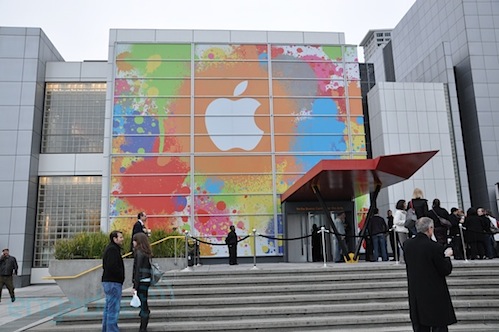
During the fruit-themed toymaker’s
special event at the Yerba Buena Center for the Arts Theater in San Francisco,
California on January 27, 2010, the company officially
announced the next mass-market ultraportable revolution that CEO
Steve Jobs deems to be the “the most advanced piece of tech that [he’s] ever
worked on at Apple."
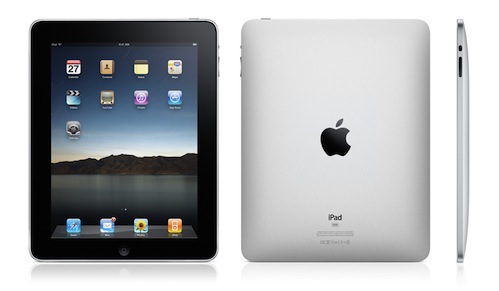
In fact, Jobs went on to explain
that the iPad is the company’s “most advanced technology in a magical &
revolutionary device at an unbelievable price.”

As the CPU and GPU-centric news
outlet that Fudzilla is, we will cut directly to the underlying hardware
details that many of our readers have been interested in most. To begin, the
Apple iPad is powered by the company’s proprietary Apple A4 1GHz processor. Not
much is known about the chip at the moment, other than the fact that it has
been kept under wraps very well from journalists, consumers and the press.
Below is a picture that Gizmodo managed to pull of the chip itself, straight
from the video demonstration of the iPad given during the event.
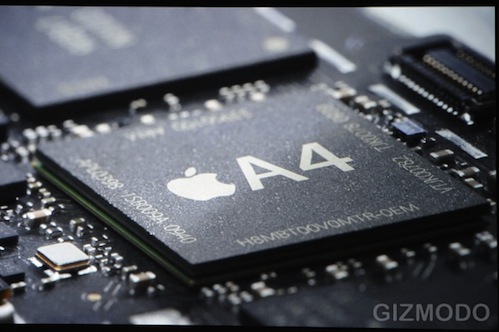
On the bottom of the chip is the
string H8MBT00V0MTR-OEM, signifying that the processor is custom silicon designed
by an Original Equipment Manufacturer, otherwise known as Palo Alto (P.A.) Semiconductor. “We’ve been able to achieve 10 hours of battery life,” said Steve Jobs during
the processor announcement. Overall, we are very interesting in acquiring
further details of the chip, particularly due to the fact that it's some sort of dual-core, ARM-based design.
On the display side of matters,
the Apple iPad features a 9.7-inch IPS panel with the same capacitive
multi-touch capabilities that many have come to know and love about the iPhone
and iPod Touch. In perspective, the InPlane Switching LCD technology
significantly improves diagonal viewing angles when compared to conventional
TFT LCD display technology, and in some cases further reduces response times
for faster pixel refresh rates.
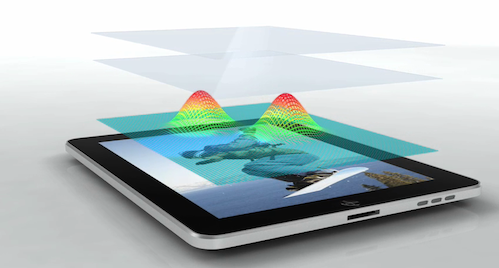
Form-factor is by far one of our
favorite aspects of the Apple iPad device. It weighs in at a mere 1.5-pounds,
lighter than any netbook currently on the market that features a 9 to 10-inch display panel.
Steve Jobs made this point very clear during the presentation, stating that “the
problem is netbooks aren’t better at anything,” followed by applause. “They’re
just cheap laptops.” In addition, the device is just 0.5-inches thin (not 0.5-inches "thick”, as that would be an inappropriate phrase to describe the
incredible form-factor of the device).
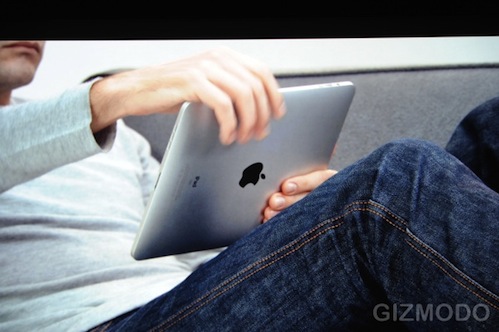
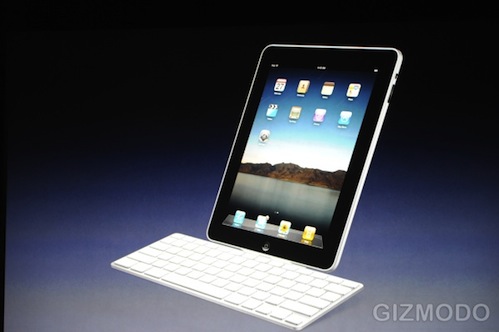
On the other hand, the device
contains all of the usual hardware internals – an accelerometer, a compass,
speakers, microphone, a dock connector, and optional 3G radio + assisted-GPS (on select models). As far as network connectivity is
concerned, every iPad model shipping will include 802.11n 300Mbps chips as well
as Bluetooth 2.1+ EDR.
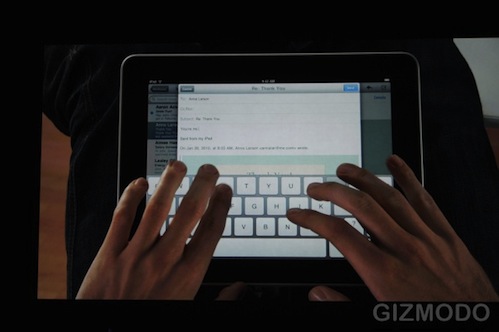
Pricing is a factor that we are simultaneously excited and disappointed about. The Apple iPad lineup
will be priced starting at $499 and moving all the way up to $829. Before you scoff at the idea of an eight-hundred-dollar oversized iPhone, let’s break
down the pricing configuration for better clarification.
Apple will sell 16GB, 32GB and
64GB configurations respectably, with an additional selling point of both WiFi-only and
WiFi + 3G models. In total, there will be 6 models of the Apple iPad, several of which are priced above and beyond the conventional netbook marketing range. Steve
Jobs pointed out that the 3G radio option adds an additional $130 to the price
tag for each model, so a 16GB WiFi-only configuration would cost $499 whereas a
16GB WiFi + 3G configuration would end up being $629. Engadget has a full
description of pricing options, including a useful chart, that can be found here.
On another note, Apple has made it clear that only the WiFi + 3G configurations feature A-GPS chips for the Maps application and other convenient location-aware applications. Once again, it is clearly obvious that the company does not want its WiFi-only customers leveraging the ability to use GPS, and this has been a major letdown for iPod Touch users since the second-generation device was announced in September 2008.
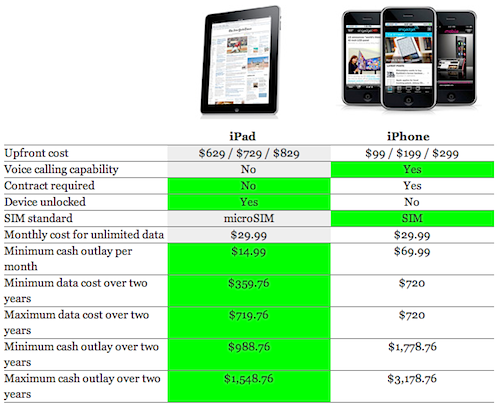
Apple iPad pricing and configuration chart, courtesy of
Engadget crew
Of course, with the additional 3G
radio option for three of the six available models, Apple has also announced
data subscription plans for its glorified tablet – and as surprising as it may
be, the company is still going to be offering them in collaboration with
AT&T. Sorry Americans, no Verizon CDMA support here.
Apple and AT&T are offering a
no-contract plan for $14.99/month that allows for a whopping 250MB of data
bandwidth. That’s right, 250 megabytes. If there was any other time to do a
facepalm, it would be right now. On the other hand, AT&T is also offering
an unlimited data subscription plan for $29.99, similar to its offering for
iPhone users on its network.
Thankfully, all Apple iPad models
are network unlocked out of the box and feature new GSM “microSIM” slots, meaning that plans
for other 3G carriers might be available soon. Unfortunately, you can’t use
your iPhone SIM card with the device due to the fact that iPhones do not use
micro-SIM cards. Although Apple has only announced subscription plans for US
customers, we are expecting the device to be available on international
networks beginning in June. Steve says they'll be back "this summer"
with news on that front.
All in all, the Apple iPad will be
available starting in late March 2010 for the WiFi-only configurations, while
the WiFi + 3G configurations will be available in late April 2010 at $130
higher price premiums. Stay tuned for more information regarding the architecture
behind the Apple A4 1GHz processor as it becomes available.
Many will certainly miss the lack of Camera, full HD resolution and the ultra high price. [sub.ed.]
Published in
News
Apple officially announces the iPad revolution


Oversized iPhone with 1GHz proprietary chip, $499 to $829
